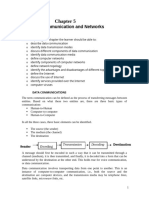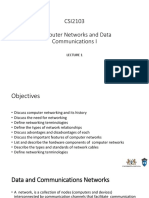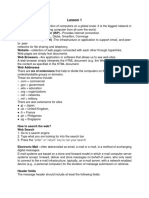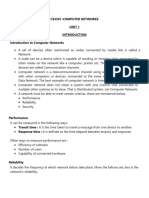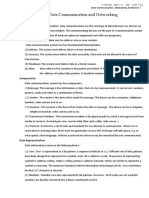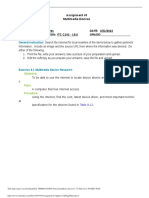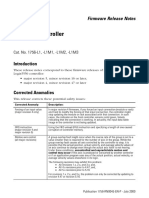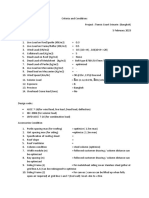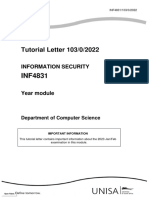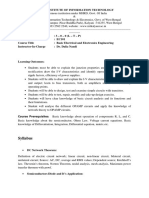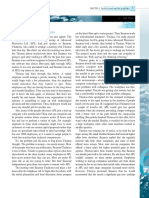12/05/2016
Communication
Communication can be defined as follows:
• The process of sharing ideas, information, and
DATA COMMUNICATION AND messages with others in a particular time and place.
• The act of conveying information.
NETWORKING • The process of transmitting and receiving ideas,
information, and messages.
Atebi Solomon • The flow of information from one point (the source) to
another (the receiver)
• Electronic transfer of information from one location to
another.
Forms of Communication Computer/Data Communication
• Verbal (talking and singing) • Computer communication is the transmission
• Nonverbal facial expressions, body language, of data and information over a
or gestures etc), communications channel between two
• Electronic (email messages, text messages etc) computers.
• Data Communication is the transmission of
data and information over a communications
channel
Elements of Communication Elements of Communication
Components required for successful Components required for successful communications:
communications • A communication device – that receives the signals
• A sending device (sender or encoder) initiates from the communication channel and converts
an instruction to transmit data, instructions or them to a form understood by the receiving device.
information It connects the sending device to a communication
• A communication channel – path over which channel. It also connects the communication
signals are sent (path, medium, line). Signals channel to a receiving device.
can be in analog or digital form. • A receiving device (receiver or decoder) that
accepts the data, instructions, information
1
� 12/05/2016
Communication Channel Communication Channel
• A transmission medium or communication • Wired Transmission Media (Physical /Guided)
channel is also referred to the pathway over • Wired media are identified by a physical cable
which data are transferred between remote on which the data travels.
devices • This cable can be seen and touched.
• There are several transmission media but all • Examples are
are put into two broad categories
– Twisted Pair,
– Wired media or Guided Media
– Coaxial Cable and
– Wireless media or Unguided Media
– Fiber Optic Cable
Communication Channel Data Transmission
• Wireless Transmission Media (Unguided) • Data transmission takes two forms
• Wireless media transmit data through high – Serial transmission
frequency radio signals or infrared light beams. – Parallel transmission
• The medium cannot be seen with the naked eye. • Serial transmission data is transmitted one bit at a
Wireless media is used when it is inconvenient, time.
impractical or impossible to install physical • Serial transmission is usually slow but very good for
cables. long distance transmission.
• Examples of wireless transmission media are • Parallel transmission: eight bits of data are
Broadcast radio, Cellular radio, Microwaves, transmitted simultaneously.
Satellites and Infrared (IR) • It is also good for short distance data transmission
Direction of Data Transmission Direction of Transmission
• Simplex direction occurs when data travels in • Half-Duplex transmission:
one direction • The flow of data is in both directions but one
• Eg like the movement of cars on a one-way at time
street.
• Transmission from TV and radio Stations
2
� 12/05/2016
Direction of Transmission Data and Signals
• Full-Duplex transmission: • A signal is an electric current or electromagnetic
field used to convey data from one place to
• Data is transmitted simultaneously and at the
another.
same time
• The simplest form of signal is a direct current
• This transmission resembles the movement of
(DC) that is switched on and off; this is the
cars on a two way street.
principle by which the early telegraph worked.
• More complex signals consist of an alternating-
current (AC) or electromagnetic carrier that
contains one or more data streams.
Data and Signals Data and Signals
• Data is superimposed on a carrier current or wave
by means of a process called modulation. • Digital data take on discrete values. For example,
• Signal modulation can be done in either of two data are stored in computer memory in the form
main ways: analog and digital. of 0s and 1 s.
• The term analog data refers to information that is
Continuous; • They can be converted to a digital signal or
• For example, an analog clock that has hour, modulated into an analog signal for transmission
minute, and second hands gives information in a across a medium.
continuous form; the movements of the hands are
continues
• Digital data refers to information that has discrete
states.
Analog and Digital Signal Modems Connectivity Options
• The word modem is the short form for
modulation-demodulation.
• Modulation is the process of converting from
digital to analog.
• Demodulation is the process of converting
from analog to digital.
3
� 12/05/2016
Modems Connectivity Options Modems Connectivity Options
• The modem enables digital microcomputers to • The higher the speed, the faster you can send and
communicate across analog telephone lines. receive information.
• This communication include both voice and •
data communications. • Uses for a Modem
• The speed with which modem transmits data • Modems are primarily used for file transfer.
varies. • Sending a file to another computer is called
• This speed, called transfer speed or transfer uploading.
rate, is typically measured in bits per second • Receiving a file from another computer is called
(bps). downloading.
Network
• A network is a group of computers and other
devices, such as printers and modems, connected
to each other.
COMPUTER NETWORKING • This enables the computers to effectively share
data and resources.
• The concept of sharing resources over a network
is called networking.
• The computers in a network can share data,
messages, graphics, printers, fax machines,
modems, and other hardware and software
resources
Network elements Network elements
• Server: Server is a the computer that provide the • Shared data: A server provides shared resources
shared resources to network users. and data over a network.
• There is usually only one server in a small network,
• The files that are provided by the server over the
network are called shared data.
but bigger networks may have more than one server.
• This shared data can be a document, a worksheet
• Clients: Clients are the computers that can access or a folder.
the shared network resources provided by a server. • Resources: Files, printers or other items that can
• Media: The computers in a network are connected to be used by network users are known as
each other by hardware components, such as cables. resources.
These components are called the media. • These resources can be either hardware or
software resources.
4
� 12/05/2016
Benefits of the Computer Network Disadvantages Computer Network
• The data can be easily sharable in a network so • Very expensive to Install
other user can access it at any time • There is an Issue of Data Insecurity
• Resource sharing is also an important benefit of
a computer network. • Cables May Break causing failure of network
• Provides centralized software management • File Server May Fail causing failure of network
• A computer network provides a powerful • Virus Infections is very high
communication medium among people spread
widely at different physical locations
• Helps organisations provide centralised security
to critical data
TYPES OF NETWORK Local Area Network (LAN)
• These are the networks that connect computers and
• Computer Networks are classified according to resources together in a building or buildings close
the distance between individual computers together such as a house, school laboratory or an
that are attached to the network. The office building.
classification includes the following: • Each computer or device on the network is called a
node Eg printers, large hard disks.
– Local Area Network (LAN)
• Generally LANs use wires (physical cables) for
– Wide Area Network (WAN)
connectivity between the devices. It is however
– Metropolitan Network (MAN) possible to connect the devices via wireless means
giving rise to what is known as a WLAN (Wireless
LAN).
Local Area Network (LAN) Metropolitan Network (MAN)
• Location: In a building or individual rooms or
• A Metropolitan Area Network (MAN) is a
floors of buildings or connecting nearby buildings
network that spans a whole metropolitan
together like a campus wide network like a college area, a district or a region.
or university.
• It is referred to as a high speed-network that
covers a city.
• These types of networks connect LANs
together within a city
• MANs use similar technology to LANs but
cover a much wider geographic region.
5
� 12/05/2016
Metropolitan Network (MAN) Wide Area Network (WAN)
• Local telecommunication services provide the • A Wide Area Network (WAN) is a network that
external connection for joining networks across covers a large geographic area such as a city
cities. country or the world.
• A consortium of users or a single network • This communication system links LANs between
provider usually manages a MAN.
cities, countries and continents.
• Location: Separate buildings distributed
throughout a city. • It uses communications channel that combines
• Examples of companies that use MANs are many types of media such as telephone lines,
universities, colleges, grocery chains, gas stations, cables, and radio waves.
department stores and banks. • A WAN can be one large network or can consist of
two or more LANs connected together.
Wide Area Network (WAN) Network Architecture
• For example, the campus spanning network • There are two (2) main types of network
that connects different departments in any architectures. These are
University or larger company is called a WAN. – Peer to Peer Network
• The Internet is the world’s largest WAN. – Client/Server Network
• The main difference between a MAN and a •
WAN is that the WAN uses Long Distance
Carriers rather than Local Exchange carriers.
• Location: City to city, across a country or
across a continent.
Network Architecture Network Architecture
Peer to Peer Network
Peer to Peer Network • And there is no administrator responsible for
• Is the type of network where each computer the entire network.
functions as both a client and a server.
• The user at each computer determines what
• In a peer-to-peer network, there are no
data on that computer is shared on the
dedicated servers, and there is no hierarchy
among the computers. network.
• All the computers are equal and therefore are
known as peers.
•
6
� 12/05/2016
Advantages of Peer-to-Peer Network Disadvantages of Peer-to-Peer network
• Less initial expense as compared to server based • There is no centralized organizational scheme to locate
networks and control access to network resources.
• Users might have to remember as many passwords as
• Easy to install and configure because Individual there are shared resources
machines do not depends on a dedicated server • When someone access shared resources, the machine
• Users are able to control their own shared where the shared resources resides suffer performance
resource hit.
• You must perform backups
• It does not need an employee to act as a • Decentralized - No Centralized server.
dedicated administrator to run the network • Security - Does not provide the security available on a
• It is sweetable for networks with 10 or less users peer-to-peer network.
Server Based Networks Server Based Networks
• Is a network that contains a dedicated server • In this network administrator centrally manages
and clients the resource and provides security.
• The server hosts and control the resources for • The administrator defines and manages user
the network access to network resources.
• The clients rely on the services that the server
provides, such as file storing and printing.
• Client computers are generally less powerful
than server computers.
Disadvantages of client/server network
Advantages of a client/server network
• Centralized - Resources and data security are • Expense - Requires initial investment in
controlled through the server.
dedicated server.
• Security - More security then Peer-to-peer
network. • Maintenance - Large networks will require a
• Flexibility - New technology can be easily integrated staff to ensure efficient operation.
into system.
• Dependence - When server goes down,
• Interoperability - All components (client /server)
work together. operations will cease across the network.
• Accessibility - Server can be accessed remotely and
across multiple platforms.
7
� 12/05/2016
Network Topologies Bus Topology
• Network Topology is the configuration or • The type of network topology in which all the
physical arrangement of the devices or nodes nodes of the network are connected to a
in a network. i.e. common transmission medium which has exactly
two endpoints called the 'bus'.
• The layout of the computers and devices on a
network. • Data transmission between nodes in the network
is over this common transmission medium (Bus)
• The 3 main topologies are and is able to be received by all nodes in the
– Bus network simultaneously.
– Ring, • It consists a single main cable that connects each
– Star. node.
Bus Topology Bus Topology
Bus • The bus transmits data in both directions.
Terminator
• Only one device can transmit at a time.
• When a sending device transmits data, the
address of the receiving device is included
with the transmission so that the data is
routed to the appropriate receiving device.
Terminator
Bus Topology Bus Topology
Advantages of a Bus Topology include: Disadvantages of a Bus Topology
• Easy to connect a computer or peripheral to a • Entire network shuts down if there is a break
linear bus. in the main cable.
• Typically the cheapest topology to implement • Terminators are required at both ends of the
backbone cable.
• Failure of one station does not affect others • Difficulty in identifying the problem if the
entire network shuts down
• Performance degrades as additional
computers are added
8
� 12/05/2016
Ring topology Ring topology
Ring
• The type of network topology in which each of
the nodes of the network is connected to two
other nodes in the network and with the first
and last nodes being connected to each other,
forming a ring.
• All data that is transmitted between nodes in Nodes
the network travels from one node to the next
node in a circular manner and the data
generally flows in a single direction.
Ring topology Ring topology
Advantages of Ring Network Disadvantages of Ring Network
• Growth of the system has minimal impact on • Often the most expensive topology to
performance
configure
• All stations have equal access
• Each node on the ring acts as a repeater (booster
• Failure of one computer may affect the entire
of the signal), allowing ring networks to span network
greater distances than other physical topologies. • Moving, adding and changes of devices can
• Because data travels in one-direction high speeds affect the network
of transmission of data is possible.
Star topology Star topology
• A star topology is designed with each node
connected directly to a central network device
known as a hub or concentrator
• Data on a star network passes through the hub or
concentrator before continuing to its destination.
• The hub or concentrator manages and controls all
functions of the network.
• It also acts as a repeater for the data flow.
• If a device fails, there is no effect on the network,
only if the hub fails that the network is affected.
9
� 12/05/2016
Star topology Star topology
• Advantages of Star Network Disadvantages of Star Network
• Easy to implement and extend, even in large • It requires more cable length than linear bus
networks • Maintenance costs may be higher in the long
• Well suited for temporary networks (quick run
setup) • Failure of the central node (hub) can disable
• The failure of a non-central node will not have the entire network
major effects on the functionality of the
network.
• Easy to detect faults
Network Components Network Components
• Networking hardware includes all computers, • Modem – Short for modulator-demodulator.
peripherals, interface cards and other equipment
needed to perform data-processing and communications • This device enables a computer to transmit data
within the network. over telephone or cable lines.
• Eg. • It converts digital signals to analog signals and
– Modem vice versa. (modulation/de-modulation).
– Network interface card- NIC
– Hub • Network interface card- NIC:
– Switch • Expansion card that is inserted into the computer
– Bridge to connect it to a network.
– Repeater
– Router
• Also call LAN Adapter.
– Gatway
Network Components Network Components
Hub (concentrator, multi-station access unit (MAU)) Switch
• is a device that provides a central point for cables in a
network. • A device that filters and forwards packets
• It usually has ports for 8 –12 devices. between LAN segments. (A packet is a piece of
• It is a common connection point for devices in a a message transmitted over a packet switching
network.
• They are commonly used to connect segments of a network. The packet contains the destination
LAN. address in addition to the data).
• When a packet arrives at a port, it is copied to the
other ports so that all segments of the LAN can see all
packets.
10
� 12/05/2016
Network Components Network Components
Bridge Repeater
• a device that connects 2 LANs or 2 segments of the • A device that accepts a signal from a medium,
same LAN that use the same protocol such as Ethernet. amplifies it, retransmits it.
• A bridge is a device that allows you to segment a large • Solves the problem of attenuation (weakening of a
signal due to distance).
network into two smaller, more efficient networks.
• It regenerates or replicates the signal
• If you are adding to an older wiring scheme and want • Repeaters can be separate devices or they can be
the new network to be up-to-date, a bridge can incorporated into a hub.
connect the two. • They are used when the total length of your network
• A bridge monitors the information traffic on both sides cable exceeds the standards set for the type of cable
of the network so that it can pass packets of being used.
information to the correct location.
Network Components Network Operating Systems
• A network operating system (NOS) is an operating
Gateway system that organizes and coordinates how multiple
users access and share resources on a network.
• A combination of hardware and software that • An NOS has more security control features.
connects networks that use different protocols.
• It also controls a network, establishes internet
• A node on a network that serves as an entrance connection and allows more than one computers to talk
to another network. to each other.
• An earlier term for router. • An NOS allows for the management of files on other
computers.
• The gateway node often acts as a proxy server
• NOS typically resides on a server.
and firewall.
• Examples of Network operating systems are Windows
NT, Windows Sever ( 2000, 2003, and 2008), Linux, Unix
11




